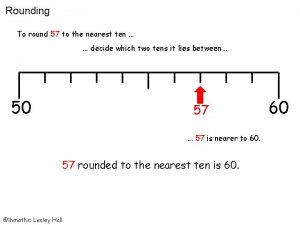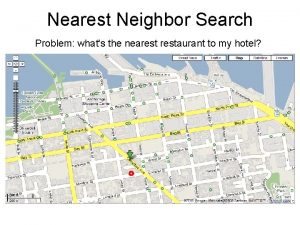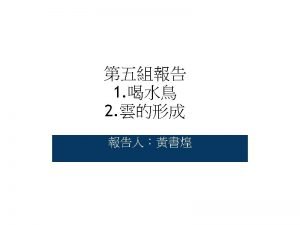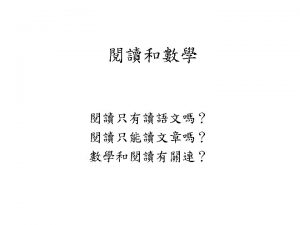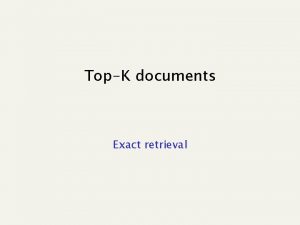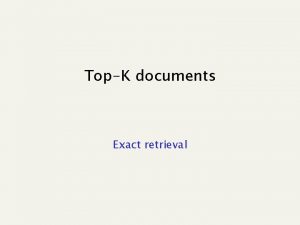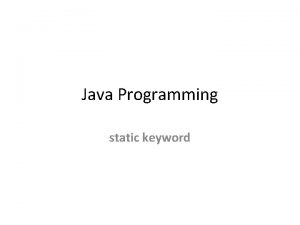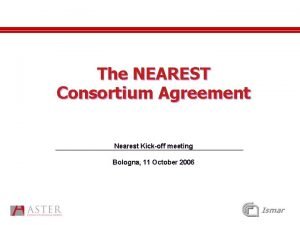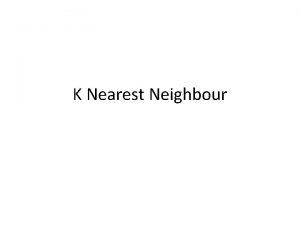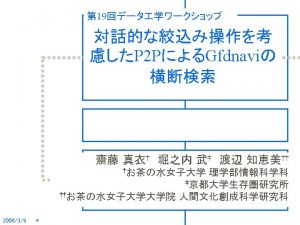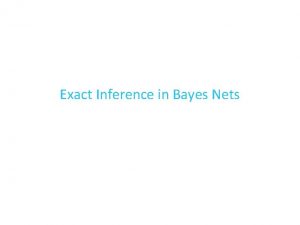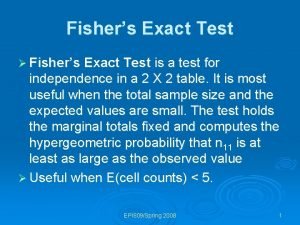Exact Topk Nearest Keyword Search in Large Networks























- Slides: 23

Exact Top-k Nearest Keyword Search in Large Networks • Minhao Jiang†, Ada Wai-Chee Fu‡, Raymond Chi-Wing Wong† • † The Hong Kong University of Science and Technology, ‡ The Chinese University of Hong Kong Prepared by Minhao Jiang Presented by Minhao Jiang 1

Motivation Social network : • In DBLP, who are the researchers that study “database” and are closely related to my supervisor? Road network: • In Melbourne, where are the nearest cinemas from my hotel showing “ 3 D” movies? 2

Problem • Given a weighted undirected graph G(V, E), where each vertex contains a set of keywords, k-Nearest Keyword Search: k-NK(q, w, k) -- what are the k nearest vertices from vertex q that contain keyword w? • e. g. k-NK(v 2, w 0, 3) = {v 2, v 0, v 6} an undirected graph with unit weighted edges 3

Outline • 1. Existing Algorithms • 2. Our Algorithm • 3. Experiments • 4. Conclusion 4

1. 1 Naive Algorithm Dijkstra-like search : too slow k-NK(v 2, w 0, 3) = {v 2, v 0, v 6} Optimal Solution 5

1. 2 Existing Index-based Algorithms All existing index-based algorithms : efficient, but cannot return the optimal solution. 1. PMI algorithm (WWW’ 12) creates the following index. k-NKPMI(v 2, w 0, 3)={v 2, v 1, v 0}, which is not correct. 2. pivot algorithm (VLDB’ 13) creates the following index. k-NKpivot(v 2, w 0, 3)={v 2, v 6, v 1}, which is not correct. k-NK(v 2, w 0, 3) = {v 2, v 0, v 6} Optimal Solution 6

2. Our Algorithm the first index-based exact algorithm which is also efficient two-hop labeling index (state-of-the-art distance querying technique [SODA 02, VLDB 13, 14, SIGMOD 12, 13]) + keyword-aware index (proposed in this paper) 7

2. 1 Background Knowledge: Two-hop Labeling Index • 1. a label set L(v) : {(v x 1, d 1), (v x 2, d 2), (v x 3, d 3)… } • 2. any dist(u, v) = min (d 1 + d 2), where (v x, d 1) ∈ L(v) and (u x, d 2) ∈ L(u) e. g. L(v 1) = {(v 1 v 0, 1), (v 1 v 1, 0)}, L(v 6) = {(v 6 v 0, 2), (v 6 v 2, 1), (v 6 v 6, 0)} dist(v 1, v 6) = 1 + 2 (by a linear scan on each of L(v 1) and L(v 6)) 8

2. 2 Forward Search(FS) Component Step 1: For each vertex vi containing the query keyword w, we find dist(q, vi) Step 2: Maintain k nearest vi to q • Efficient when w is infrequent 9

2. 3 Forward Backward Search(FBS) Component (q xi, di) ∈ L(q) (xi q, di) ∈ LB(xi) • Step 1: scan (q xi, di) in L(q) • Step 2: for each xi (a). scan (xi yij, dij) in LB(xi) (b). find k shortest (xi yij, dij) such that yij contains w (c). maintain the best-known answers Efficient when w is frequent by KT index priority queue 10

2. 3 KT index • Step 2(b): for each xi, find k shortest (xi yij, dij) in LB(xi) such that yij contains w. Naive method: O(|LB(xi)|) : a linear scan KT index: O( klog(|LB(xi)|/k) ) : e. g. when LB(xi) = {(xi y 0, d 0), …, (xi y 12, d 12)} (2). index the keywords of all yij components in all entries in LB(xi) by the hash value (stored in each tree node) (1). sort (xi yij, dij) by dij, and build a binary tree forest by KT index 11

2. 4 FS-FBS Algorithm Combine FS and FBS: • 1. If the query keyword is frequent, - use the FBS method. • 2. If the query keyword is not frequent, - use the FS method. 12

2. 5 Extension 1. Disk-based setting 2. Multiple keyword query 3. Dynamic update 13

3. Experiments • Datasets: millions of vertices 14

3. 1 Querying Efficiency • • PMI: WWW’ 12 index-based algorithm pivot-gs: VLDB’ 13 index-based algorithm FS-FBS: our exact algorithm Dijkstra: naive exact algorithm HR(hit rate): % of reported vertices that are in the optimal solution. S-ρ(spearman’s rho): correlation between the reported ranking and the optimal ranking. value = 1. 00 Output is the optimal solution • Existing index-based algorithms are inaccurate • Our exact algorithm is as efficient as existing index-based algorithms 15

3. 2 Indexing Cost • Index Size: comparable with existing index-based algorithms • Indexing Time: acceptable 16

4. Conclusion 1. Our method can handle k-NK queries in large networks. 2. We propose the first index-based algorithm returning the optimal solution. 3. Our method is as efficient as the best-known index-based algorithms (returning non-optimal answers). 17

END 18

2. 3 Forward Backward Search(FBS) Algorithm • How to obtain k shortest (xi yij, dij) in LB(xi) such that yij contains w ? 1. Sort (xi yij, dij) by non-ascending dij in each LB(xi) k shortest (xi yij, dij) with yij containing w are at the end of LB(x) • 2. Hierarchy: • e. g. when LB(x) = {(x y 0, d 0), …, (x y 12, d 12)} • Project keyword to hash value : • e. g. h(w) = 00010000 • h[8. . 11] = h(w 1) bitwise. OR h(w 2) bitwise. OR h(w 3)…… where wi is in y 8, y 9, y 10 or y 11, • if h[8. . 11] bitwise. AND h(w) = 0, w is not contained in y 8, y 9, y 10 and y 1, we check h[0. . 7], otherwise, we check h[10. . 11] 19

2. 3 Forward Backward Search(FBS) Algorithm • How to obtain k shortest (xi yij, dij) in LB(xi) such that yij contains w ? 1. Sort (xi yij, dij) by non-ascending dij 2. Hierarchy 3. Store hierarchy in array: • e. g. [8. . 11] is in a[19] compact storage without loss of efficiency in searching • One FBS time complexity : where |L| is the size of the 2 -hop index, |doc(V)| is the total number of keywords in the graph 20

2. 5 Adapt to Disk-based Setting 1. Keyword w related backward index for each w : LB Lw 2. Partition each Lw into high index and low index • e. g. when w is contained in v 1, v 3 and v 4 21

2. 5 Adapt to Multiple Keywords Query 1. Trivial in FS 2. Same hierarchy in FBS 3. Modify recursive search by • Disjunctive/OR: if h[8. . 11] bitwise. AND (h(w 1) bitwise. OR h(w 2) …) = 0, w is not contained in y 8, y 9, y 10 and y 1, we check h[0. . 7], otherwise, we check h[10. . 11] • Conjunctive/AND: if h[8. . 11] bitwise. AND (h(w 1) bitwise. OR h(w 2) …) < h[8. . 11], w is not contained in y 8, y 9, y 10 and y 1, we check h[0. . 7], otherwise, we check h[10. . 11] 22

2. 5 Adapt to Dynamic Update 1. Keyword Update Trivial in FS 2. Keyword Update hierarchy in FBS: • When keyword w is inserted into / removed from vertex v, each LB(u) that contains (u v, d) should update its hierarchy by reconstructing the hash value from root to v 3. Structure Update: • 3. 1 Update 2 -hop by existing algorithms • 3. 2 Update keyword-related information accordingly 23
 Keyword search techniques
Keyword search techniques Keyword generation for search engine advertising
Keyword generation for search engine advertising Internet search keywords
Internet search keywords Round off 57 to the nearest tens
Round off 57 to the nearest tens Image and video upscaling from local self examples
Image and video upscaling from local self examples Virtual circuit approach
Virtual circuit approach Basestore iptv
Basestore iptv Large scale distributed deep networks
Large scale distributed deep networks Finding community structure in very large networks
Finding community structure in very large networks Quadtree
Quadtree Approximate nearest neighbor search in high dimensions
Approximate nearest neighbor search in high dimensions The anatomy of a large-scale hypertextual web search engine
The anatomy of a large-scale hypertextual web search engine The anatomy of a large-scale hypertextual web search engine
The anatomy of a large-scale hypertextual web search engine The anatomy of a large scale hypertextual web search engine
The anatomy of a large scale hypertextual web search engine The anatomy of a large scale hypertextual web search engine
The anatomy of a large scale hypertextual web search engine Which search strategy is also called as blind search?
Which search strategy is also called as blind search? Search by image
Search by image Informed and uninformed search in artificial intelligence
Informed and uninformed search in artificial intelligence Video.search.yahoo.com search video
Video.search.yahoo.com search video Federated search vs discovery
Federated search vs discovery Yahoo shopping tw
Yahoo shopping tw Http://search.yahoo.com/search?ei=utf-8
Http://search.yahoo.com/search?ei=utf-8 Images.search.yahoo.com
Images.search.yahoo.com Tw.search.yahoo.com
Tw.search.yahoo.com



